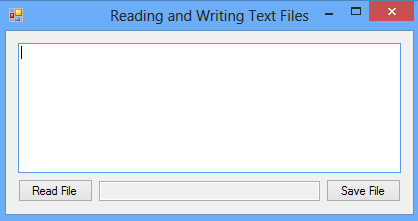-
Read And Write Text File Visual Basic카테고리 없음 2020. 3. 2. 09:54

Read and Write CSV file in Vb.Net: Today’s article for read and write.CSV file, we are using the FileIo namespace for writing CSV file and OLEDB ADO.NET connectivity to read the CSV file.Comma-separated values(CSV) is not a single, well-defined format it sometimes also called character-separated values. Comma separated values text files (.csv), in which the comma character (,) typically separates each field of text.In a comma-separated values (CSV) file the data items are separated using commas as a delimiter, while in a tab-separated values (TSV) file, the data items are separated using tabs as a delimiter.

Read And Write Text File Visual Basic Pdf
Column headers are sometimes included as the first line, and each subsequent line is a row of data.
Report this ad FileMode OptionsADSDAQBOXFLOWModeDescriptionAppendIf the file exists it is opened. Any writes are appended to the end of the file.Requires FileAccess.Write modeCreateCreates a new file, removing old file if it already existsCreateNewCreates a new file and returns error if file already existsOpenOpens an existing file. Returns error if file does not existOpenOrCreateIf file already exists it is opened, otherwise a new file is createdTruncateOpens an existing file and deletes all existing content.
Writing to a File with Visual BasicOnce a file has been opened with the appropriate options, it can be written to using the Visual Basic StreamWriter class. The StreamWriter constructor takes a FileStream as the sole parameter.The Write and WriteLine methods of the StreamWriter class are then used to write to the file. Write writes the text with no new line appended to the end of each line.
Reading From a File in Visual BasicNow that we have created and written to a file the next step is to read some data from the file. This is achieved using the Visual Basic StreamReader object.The StreamReader ReadLine method can be used to read the next line from the file stream including the new line. The Read method reads a line from the file but removes the new line. Detecting a Change to a FileA Visual Basic can monitor a file and receive notification from the operating system when the file is changed by any program. This is achieved using the Visual Basic FileSystemWatcher class.To try this, start Visual Studio and create a new Windows Application project. Access the Toolbox and double click on the FileSystemWatcher control from the Components section of the list.
The new object will appear beneath the Form design area with the name FileSystemWatcher1. Select the object and use the Properties panel to change the Path to C:Temp and the Filter property to test.txt.Double click on the FileSystemWatcher1 object to access the event procedure code and modify the changed event as follows:Private Sub FileSystemWatcher1Changed(ByVal sender As System.Object,ByVal e As System.IO.FileSystemEventArgs) Handles FileSystemWatcher1.ChangedMessageBox.Show('File changed')End SubPress F5 to build and run the application and, using Notepad, edit and save the file.

As soon as the changes are saved, the 'File Changed' MessageBox will appear. Note that the NotifyFilter property can be used to configure which events trigger an notification.Now that we have covered file handling in Visual Basic the next step is to look at directories in.